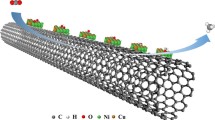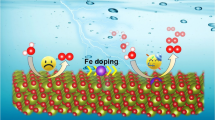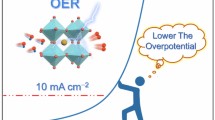Abstract
The sluggish kinetics of the oxygen reduction reaction (ORR) is a major hurdle for the development of efficient fuel cells. The conventional Pt based catalysts being very expensive, development of noble metal free catalysts for accelerating the kinetics of ORR is highly important. Here, we explored the transition metal (Fe, Co, Ni and Cu) decorated over the nitrogen and phosphorous co-doped graphene as a single-atom catalyst for ORR. Among the four metal decorated systems considered, oxygen molecule is found to strongly interact with only Fe and Co systems while it was too weak with the Ni and Cu systems. Both the Fe and Co decorated systems were systematically investigated for their activity towards ORR through the four-electron reduction path. From the free energies calculated for all the intermediate reactions of ORR, Fe-decorated system was found to have lower overpotential as compared to that of the Co-decorated system indicating the former one as a better catalyst for ORR.




Similar content being viewed by others
References
Grätzel M (2000) Powering the planet. Nature 403:363–363. https://doi.org/10.1038/35000273
Gray HB (2009) Powering the planet with solar fuel. Nat Chem 1:7–7. https://doi.org/10.1038/nchem.141
Lewis NS, Nocera DG (2006) Powering the planet: chemical challenges in solar energy utilization. Proc Natl Acad Sci 103:15729–15735. https://doi.org/10.1073/pnas.0603395103
Gielen D, Boshell F, Saygin D et al (2019) The role of renewable energy in the global energy transformation. Energy Strategy Rev 24:38–50. https://doi.org/10.1016/j.esr.2019.01.006
Wang Y, Ruiz Diaz DF, Chen KS et al (2020) Materials, technological status, and fundamentals of PEM fuel cells – a review. Mater Today 32:178–203. https://doi.org/10.1016/j.mattod.2019.06.005
Jiao K, Xuan J, Du Q et al (2021) Designing the next generation of proton-exchange membrane fuel cells. Nature 595:361–369. https://doi.org/10.1038/s41586-021-03482-7
Wang Z, Jin X, Zhu C et al (2021) Atomically dispersed Co2–N6 and Fe–N4 costructures boost oxygen reduction reaction in both alkaline and acidic media. Adv Mater 33:2104718. https://doi.org/10.1002/adma.202104718
Wang XX, Swihart MT, Wu G (2019) Achievements, challenges and perspectives on cathode catalysts in proton exchange membrane fuel cells for transportation. Nat Catal 2:578–589. https://doi.org/10.1038/s41929-019-0304-9
Ren X, Wang Y, Liu A et al (2020) Current progress and performance improvement of Pt/C catalysts for fuel cells. J Mater Chem A 8:24284–24306. https://doi.org/10.1039/D0TA08312G
Ren X, Lv Q, Liu L et al (2020) Current progress of Pt and Pt-based electrocatalysts used for fuel cells. Sustain Energy Fuels 4:15–30. https://doi.org/10.1039/C9SE00460B
Li H, Kelly S, Guevarra D et al (2021) Analysis of the limitations in the oxygen reduction activity of transition metal oxide surfaces. Nat Catal 4:463–468. https://doi.org/10.1038/s41929-021-00618-w
Wu D, Shen X, Pan Y et al (2020) Platinum alloy catalysts for oxygen reduction reaction: advances, challenges and perspectives. ChemNanoMat 6:32–41. https://doi.org/10.1002/cnma.201900319
Goswami C, Hazarika KK, Bharali P (2018) Transition metal oxide nanocatalysts for oxygen reduction reaction. Mater Sci Energy Technol 1:117–128. https://doi.org/10.1016/j.mset.2018.06.005
Wang Y, Li J, Wei Z (2018) Transition-metal-oxide-based catalysts for the oxygen reduction reaction. J Mater Chem A 6:8194–8209. https://doi.org/10.1039/C8TA01321G
Zhong Y, Xia X, Shi F et al (2016) Transition metal carbides and nitrides in energy storage and conversion. Adv Sci 3:1500286. https://doi.org/10.1002/advs.201500286
Kiran V, Srinivasu K, Sampath S (2013) Morphology dependent oxygen reduction activity of titanium carbide: bulk vs. nanowires. Phys Chem Chem Phys 15:8744–8751. https://doi.org/10.1039/C3CP50731A
Regmi YN, Waetzig GR, Duffee KD et al (2015) Carbides of group IVA, VA and VIA transition metals as alternative HER and ORR catalysts and support materials. J Mater Chem A 3:10085–10091. https://doi.org/10.1039/C5TA01296A
Ma L, Shen X, Zhou H et al (2015) CoP nanoparticles deposited on reduced graphene oxide sheets as an active electrocatalyst for the hydrogen evolution reaction. J Mater Chem A 3:5337–5343. https://doi.org/10.1039/C4TA06458E
In situ Free-Surfactant Synthesis and ORR- Electrochemistry of Carbon-Supported Co3S4 and CoSe2 Nanoparticles | Chemistry of Materials. https://pubs.acs.org/doi/full/https://doi.org/10.1021/cm7024763?casa_token=l9PKrO-6_e0AAAAA:Im31gwErc3_JVDujGbKkTibclg7d2dUb7qRJKM7jM0BHKJruwHEcXpB_yUF8MDya6-cKjKNY_5K0g7pi. Accessed 22 Jan 2023
Metal-free doped carbon materials as electrocatalysts for the oxygen reduction reaction - Journal of Materials Chemistry A (RSC Publishing) DOI: https://doi.org/10.1039/C3TA14043A. https://pubs.rsc.org/en/content/articlehtml/2013/ta/c3ta14043a. Accessed 21 Jan 2023
Shao Y, Jiang Z, Zhang Q, Guan J (2019) Progress in nonmetal-doped graphene electrocatalysts for the oxygen reduction reaction. Chemsuschem 12:2133–2146. https://doi.org/10.1002/cssc.201900060
Peera SG, Maiyalagan T, Liu C et al (2021) A review on carbon and non-precious metal based cathode catalysts in microbial fuel cells. Int J Hydrog Energy 46:3056–3089. https://doi.org/10.1016/j.ijhydene.2020.07.252
Chen Z, Higgins D, Yu A et al (2011) A review on non-precious metal electrocatalysts for PEM fuel cells. Energy Environ Sci 4:3167–3192. https://doi.org/10.1039/C0EE00558D
Du R, Zhang N, Zhu J et al (2015) Nitrogen-doped carbon nanotube aerogels for high-performance ORR catalysts. Small 11:3903–3908. https://doi.org/10.1002/smll.201500587
Tong X, Wei Q, Zhan X et al (2017) The new graphene family materials: synthesis and applications in oxygen reduction reaction. Catalysts 7:1. https://doi.org/10.3390/catal7010001
Elangovan A, Xu J, Brown E et al (2020) Fundamental electrochemical insights of vertically aligned carbon Nanofiber architecture as a catalyst support for ORR. J Electrochem Soc. https://doi.org/10.1149/1945-7111/ab86c1
Kannan MV, Gnana kumar G, (2016) Current status, key challenges and its solutions in the design and development of graphene based ORR catalysts for the microbial fuel cell applications. Biosens Bioelectron 77:1208–1220. https://doi.org/10.1016/j.bios.2015.10.018
Zhang C, Mahmood N, Yin H et al (2013) Synthesis of phosphorus-doped graphene and its multifunctional applications for oxygen reduction reaction and lithium ion batteries. Adv Mater 25:4932–4937. https://doi.org/10.1002/adma.201301870
Ma TY, Ran J, Dai S et al (2015) Phosphorus-doped graphitic carbon nitrides grown in situ on carbon-fiber paper: flexible and reversible oxygen electrodes. Angew Chem 127:4729–4733. https://doi.org/10.1002/ange.201411125
del Cueto M, Ocón P, Poyato JML (2015) Comparative study of oxygen reduction reaction mechanism on nitrogen-, phosphorus-, and boron-doped graphene surfaces for fuel cell applications. J Phys Chem C 119:2004–2009. https://doi.org/10.1021/jp512588r
Bayatsarmadi B, Zheng Y, Jaroniec M, Qiao SZ (2015) Soft-templating synthesis of N-doped Mesoporous carbon Nanospheres for enhanced oxygen reduction reaction. Chem Asian J. https://doi.org/10.1102/asia.201500287
Hu C, Yu C, Li M et al (2015) Nitrogen-doped carbon dots decorated on graphene: a novel all-carbon hybrid electrocatalyst for enhanced oxygen reduction reaction. Chem Commun 51:3419–3422. https://doi.org/10.1039/C4CC08735F
Sun X, Xu J, Ding Y et al (2015) The effect of different phosphorus chemical states on an onion-like carbon surface for the oxygen reduction reaction. Chemsuschem 8:2872–2876. https://doi.org/10.1002/cssc.201500154
Shui J, Wang M, Du F, Dai L (2015) N-doped carbon nanomaterials are durable catalysts for oxygen reduction reaction in acidic fuel cells. Sci Adv. https://doi.org/10.1126/sciadv.1400129
Feng L, Qin Z, Huang Y et al (2020) Boron-, sulfur-, and phosphorus-doped graphene for environmental applications. Sci Total Environ. https://doi.org/10.1016/j.scitotenv.2019.134239
Zhang J, Dai L (2016) Nitrogen, phosphorus, and fluorine tri-doped graphene as a multifunctional catalyst for Self-powered electrochemical water splitting. Angew Chem Int Ed 55:13296–13300. https://doi.org/10.1002/anie.201607405
Razmjooei F, Singh KP, Song MY, Yu J-S (2014) Enhanced electrocatalytic activity due to additional phosphorous doping in nitrogen and sulfur-doped graphene: a comprehensive study. Carbon 78:257–267. https://doi.org/10.1016/j.carbon.2014.07.002
Liang Z, Liu C, Chen M et al (2019) Oxygen reduction reaction mechanism on P, N co-doped graphene: a density functional theory study. New J Chem 43:19308–19317. https://doi.org/10.1039/C9NJ04808A
Chai G-L, Qiu K, Qiao M et al (2017) Active sites engineering leads to exceptional ORR and OER bifunctionality in P, N Co-doped graphene frameworks. Energy Environ Sci 10:1186–1195. https://doi.org/10.1039/C6EE03446B
Yang X-F, Wang A, Qiao B et al (2013) Single-atom catalysts: a new frontier in heterogeneous catalysis. Acc Chem Res 46:1740–1748. https://doi.org/10.1021/ar300361m
Wang A, Li J, Zhang T (2018) Heterogeneous single-atom catalysis. Nat Rev Chem 2:65–81. https://doi.org/10.1038/s41570-018-0010-1
Ren S, Yu Q, Yu X et al (2020) Graphene-supported metal single-atom catalysts: a concise review. Sci China Mater 63:903–920. https://doi.org/10.1007/s40843-019-1286-1
Liang S, Hao C, Shi Y (2015) The power of single-atom catalysis. ChemCatChem 7:2559–2567. https://doi.org/10.1002/cctc.201500363
Zhang Q, Zhang X, Wang J, Wang C (2020) Graphene-supported single-atom catalysts and applications in electrocatalysis. Nanotechnology. https://doi.org/10.1088/1361-6528/abbd70
Beniya A, Higashi S (2019) Towards dense single-atom catalysts for future automotive applications. Nat Catal 2:590–602. https://doi.org/10.1038/s41929-019-0282-y
Zhang X, Xia Z, Li H et al (2019) The mechanism and activity of oxygen reduction reaction on single atom doped graphene: a DFT method. RSC Adv 9:7086–7093. https://doi.org/10.1039/C9RA00167K
Wan C, Duan X, Huang Y (2020) Molecular design of single-atom catalysts for oxygen reduction reaction. Adv Energy Mater 10:1903815. https://doi.org/10.1002/aenm.201903815
Srinivasu K, Ghosh SK (2013) Transition metal decorated graphyne: an efficient catalyst for oxygen reduction reaction. J Phys Chem C 117:26021–26028. https://doi.org/10.1021/jp407007n
Masa J, Xia W, Muhler M, Schuhmann W (2015) On the role of metals in nitrogen-doped carbon electrocatalysts for oxygen reduction. Angew Chem Int Ed 54:10102–10120. https://doi.org/10.1002/anie.201500569
Kattel S, Wang G (2013) A density functional theory study of oxygen reduction reaction on Me–N4 (Me = Fe Co, or Ni) clusters between graphitic pores. J Mater Chem A 1:10790–10797. https://doi.org/10.1039/C3TA12142A
Kattel S, Atanassov P, Kiefer B (2014) A density functional theory study of oxygen reduction reaction on non-PGM Fe–N x –C electrocatalysts. Phys Chem Chem Phys 16:13800–13806. https://doi.org/10.1039/C4CP01634C
Li M, Lv Q, Si W et al (2022) Sp-Hybridized nitrogen as new anchoring sites of iron single atoms to boost the oxygen reduction reaction. Angew Chem Int Ed. https://doi.org/10.1002/anie.202208238
Singh KP, Bae EJ, Yu J-S (2015) Fe–P: A new class of electroactive catalyst for oxygen reduction reaction. J Am Chem Soc 137:3165–3168. https://doi.org/10.1021/ja511759u
Razmjooei F, Singh KP, Bae EJ, Yu J-S (2015) A new class of electroactive Fe- and P-functionalized graphene for oxygen reduction. J Mater Chem A 3:11031–11039. https://doi.org/10.1039/C5TA00970G
Chen J, Li H, Fan C et al (2020) Dual Single-Atomic Ni-N4 and Fe-N4 Sites constructing janus hollow graphene for selective oxygen electrocatalysis. Adv Mater 32:2003134. https://doi.org/10.1002/adma.202003134
Li H, Wen Y, Jiang M et al (2021) Understanding of neighboring Fe-N4-C and Co-N4-C dual active centers for oxygen reduction reaction. Adv Funct Mater 31:2011289. https://doi.org/10.1002/adfm.202011289
Wang S, Huang B, Dai Y, Wei W (2023) Tuning the coordination microenvironment of central Fe active site to boost water electrolysis and oxygen reduction activity. Small 19:2205111. https://doi.org/10.1002/smll.202205111
Shao C, Wu L, Zhang H et al (2021) A versatile approach to boost oxygen reduction of Fe-N4 Sites by controllably incorporating sulfur functionality. Adv Funct Mater 31:2100833. https://doi.org/10.1002/adfm.202100833
Shi C, Maimaitiyiming X (2021) FeNi-functionalized 3D N,P doped graphene foam as a noble metal-free bifunctional electrocatalyst for direct methanol fuel cells. J Alloys Compd https://doi.org/10.1016/j.jallcom.2021.158732
Li J, Fan K, Jiang H et al (2022) Boosting the oxygen reduction reaction behaviour of atomic Fe–N4 active sites in porous honeycomb-like carbon via P heteroatom doping. J Mater Chem A 10:18147–18155. https://doi.org/10.1039/D2TA04255J
Liu K, Fu J, Lin Y et al (2022) Insights into the activity of single-atom Fe-N-C catalysts for oxygen reduction reaction. Nat Commun 13:2075. https://doi.org/10.1038/s41467-022-29797-1
Liang W, Chen J, Liu Y, Chen S (2014) Density-functional-theory calculation analysis of active sites for four-Electron reduction of O2 on Fe/N-doped graphene. ACS Catal 4:4170–4177. https://doi.org/10.1021/cs501170a
McClure JP, Borodin O, Olguin M et al (2016) Sensitivity of density functional theory methodology for oxygen reduction reaction predictions on Fe–N4-containing graphitic clusters. J Phys Chem C 120:28545–28562. https://doi.org/10.1021/acs.jpcc.6b08498
Dutta S, Banerjee P, Pati SK (2022) Computational insight into TM–Nx embedded graphene bifunctional electrocatalysts for oxygen evolution and reduction reactions. ACS Phys Chem Au 2:305–315. https://doi.org/10.1021/acsphyschemau.2c00003
Feng L, Liu Y, Zhao J (2015) Fe– and Co–P 4 -embedded graphenes as electrocatalysts for the oxygen reduction reaction: theoretical insights. Phys Chem Chem Phys 17:30687–30694. https://doi.org/10.1039/C5CP05551B
Kresse G, Furthmüller J (1996) Efficiency of ab-initio total energy calculations for metals and semiconductors using a plane-wave basis set. Comput Mater Sci 6:15–50. https://doi.org/10.1016/0927-0256(96)00008-0
Kresse G, Furthmüller J (1996) Efficient iterative schemes for ab initio total-energy calculations using a plane-wave basis set. Phys Rev B 54:11169–11186. https://doi.org/10.1103/PhysRevB.54.11169
Kresse G, Joubert D (1999) From ultrasoft pseudopotentials to the projector augmented-wave method. Phys Rev B 59:1758–1775. https://doi.org/10.1103/PhysRevB.59.1758
Blöchl PE (1994) Projector augmented-wave method. Phys Rev B 50:17953–17979. https://doi.org/10.1103/PhysRevB.50.17953
Perdew JP, Burke K, Ernzerhof M (1996) Generalized gradient approximation made simple. Phys Rev Lett 77:3865–3868. https://doi.org/10.1103/PhysRevLett.77.3865
Grimme S, Ehrlich S, Goerigk L (2011) Effect of the damping function in dispersion corrected density functional theory. J Comput Chem 32:1456–1465. https://doi.org/10.1002/jcc.21759
Monkhorst HJ, Pack JD (1976) Special points for Brillouin-zone integrations. Phys Rev B 13:5188–5192. https://doi.org/10.1103/PhysRevB.13.5188
Schaftenaar G, Noordik JH (2000) Molden: a pre- and post-processing program for molecular and electronic structures*. J Comput Aided Mol Des 14:123–134. https://doi.org/10.1023/A:1008193805436
Momma K, Izumi F (2011) VESTA 3 for three-dimensional visualization of crystal, volumetric and morphology data. J Appl Crystallogr 44:1272–1276. https://doi.org/10.1107/S0021889811038970
Nørskov JK, Rossmeisl J, Logadottir A et al (2004) Origin of the overpotential for oxygen reduction at a fuel-cell cathode. J Phys Chem B 108:17886–17892. https://doi.org/10.1021/jp047349j
Computational Chemistry Comparison and Benchmark Database. http://cccbdb.nist.gov/
Henkelman G, Arnaldsson A, Jónsson H (2006) A fast and robust algorithm for Bader decomposition of charge density. Comput Mater Sci 36:354–360. https://doi.org/10.1016/j.commatsci.2005.04.010
Tang W, Sanville E, Henkelman G (2009) A grid-based bader analysis algorithm without lattice bias. J Phys Condens Matter. https://doi.org/10.1088/0953-8984/21/8/084204
Yu M, Trinkle DR (2011) Accurate and efficient algorithm for Bader charge integration. J Chem Phys. https://doi.org/10.1063/1.3553716
Orellana W (2013) Catalytic properties of transition metal–N4 moieties in Graphene for the oxygen reduction reaction: evidence of spin-dependent mechanisms. J Phys Chem C 117:9812–9818. https://doi.org/10.1021/jp4002115
Acknowledgements
I thank the BARC computer centre for providing the high-performance parallel computing facility. I also thank Dr T. Bandyopadhyay and Dr A. K. Tyagi for their continues encouragement and support.
Author information
Authors and Affiliations
Contributions
Srinivasu Kancharlapalli planned, executed the calculations and wrote the manuscript
Corresponding author
Ethics declarations
Conflict of interest
The authors declare no competing interests.
Additional information
Publisher's Note
Springer Nature remains neutral with regard to jurisdictional claims in published maps and institutional affiliations.
Supplementary Information
Below is the link to the electronic supplementary material.
Rights and permissions
Springer Nature or its licensor (e.g. a society or other partner) holds exclusive rights to this article under a publishing agreement with the author(s) or other rightsholder(s); author self-archiving of the accepted manuscript version of this article is solely governed by the terms of such publishing agreement and applicable law.
About this article
Cite this article
Kancharlapalli, S. Transition metal-N2P2 embedded graphene (TM-NPC) as single-atom catalyst for oxygen reduction reaction: a computational study. Theor Chem Acc 142, 77 (2023). https://doi.org/10.1007/s00214-023-03015-7
Received:
Accepted:
Published:
DOI: https://doi.org/10.1007/s00214-023-03015-7




